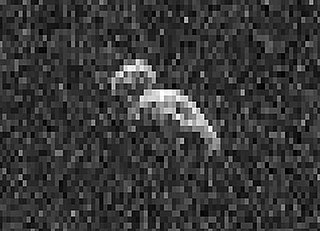
A near-Earth object (NEO) is any small Solar System body orbiting the Sun whose closest approach to the Sun (perihelion) is less than 1.3 times the Earth–Sun distance. This definition applies to the object's orbit around the Sun, rather than its current position, thus an object with such an orbit is considered an NEO even at times when it is far from making a close approach of Earth. If an NEO's orbit crosses the Earth's orbit, and the object is larger than 140 meters (460 ft) across, it is considered a potentially hazardous object (PHO). Most known PHOs and NEOs are asteroids, but about 0.35% are comets.

Comet Encke, or Encke's Comet, is a periodic comet that completes an orbit of the Sun once every 3.3 years. Encke was first recorded by Pierre Méchain on 17 January 1786, but it was not recognized as a periodic comet until 1819 when its orbit was computed by Johann Franz Encke. Like Halley's Comet, it is unusual in its being named after the calculator of its orbit rather than its discoverer. Like most comets, it has a very low albedo, reflecting only 4.6% of the light its nucleus receives, although comets generate a large coma and tail that can make them much more visible during their perihelion. The diameter of the nucleus of Encke's Comet is 4.8 km.

12P/Pons–Brooks is a periodic comet with an orbital period of 71 years. Comets with an orbital period of 20–200 years are referred to as Halley-type comets. It is one of the brightest known periodic comets, reaching an absolute visual magnitude of about 5 in its approach to perihelion. Comet Pons-Brooks was conclusively discovered at Marseilles Observatory in July 1812 by Jean-Louis Pons, and on its next appearance in 1883 by William Robert Brooks. There are ancient records of comets that are suspected of having been apparitions of 12P/Pons–Brooks.
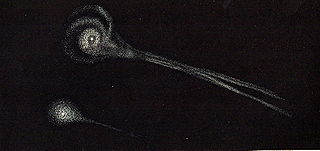
Biela's Comet or Comet Biela was a periodic Jupiter-family comet first recorded in 1772 by Montaigne and Messier and finally identified as periodic in 1826 by Wilhelm von Biela. It was subsequently observed to split in two and has not been seen since 1852. As a result, it is currently considered to have been destroyed, although remnants have survived for some time as a meteor shower, the Andromedids which may show increased activity in 2023.
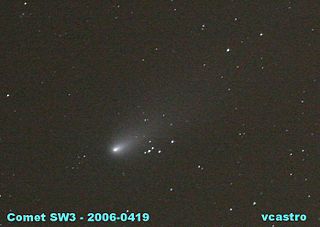
73P/Schwassmann–Wachmann, also known as Schwassmann–Wachmann 3 or SW3 for short, is a periodic comet that has a 5.4 year orbital period and that has been actively disintegrating since 1995. When it came to perihelion in March 2017, fragment 73P-BT was separating from the main fragment 73P-C. Fragments 73P-BU and 73P-BV were detected in July 2022. The main comet came to perihelion on 25 August 2022, when the comet was 0.97 AU from the Sun and 1 AU from Earth. It will be less than 80 degrees from the Sun from 25 May 2022 until August 2023. On 3 April 2025 it will make a modest approach of 0.3 AU to Jupiter. 73P will next come to perihelion on 23 December 2027 when it will be 0.92 AU from the Sun and on the far side of the Sun 1.9 AU from Earth.
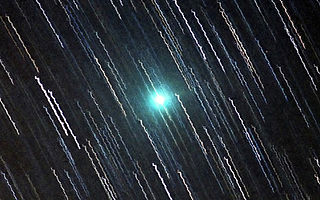
Comet IRAS–Araki–Alcock is a long-period comet that, in 1983, made the closest known approach to Earth of any comet in 200 years, at a distance of about 0.0312 AU. The comet was named after its discoverers – the Infrared Astronomical Satellite and two amateur astronomers, George Alcock of the United Kingdom and Genichi Araki of Japan. Both men were schoolteachers by profession, although Alcock was retired. Alcock had made his discovery simply by observing through the window of his home, using binoculars. During the closest approach, the comet appeared as a circular cloud about the size of the full moon, having no discernible tail, and shining at a naked eye magnitude of 3–4. It swept across the sky at an angular speed of about 30 degrees per day. On May 11 the comet was detected on radar by Arecibo Observatory and Goldstone Solar System Radar making it the first comet detected by two different radar systems. A second detection was made by Goldstone on 14 May.

6P/d'Arrest is a periodic Jupiter-family comet in the Solar System, orbiting between Mars and Jupiter. It passed 0.15124 AU from the Earth on August 12, 1976. The most recent perihelion passage took place on September 17, 2021, when the comet had a solar elongation of 95 degrees at approximately apparent magnitude of 10.

7P/Pons–Winnecke is a periodic Jupiter-family comet with a six-year orbit. Early calculations for the 1921 apparition suggested that the orbit of the comet might collide with Earth in June, but observations on 10 April ruled out an impact. It made a very close approach to Earth in June 1927. The outward migration of perihelion created impressive meteor showers in 1916, 1921 and 1927.

11P/Tempel–Swift–LINEAR is a periodic Jupiter-family comet in the Solar System.

Comet Finlay is a periodic comet with an orbital period of 6 years discovered by William Henry Finlay on September 26, 1886. The next perihelion passage is July 13, 2021 when the comet will have a solar elongation of 54 degrees at approximately apparent magnitude 10. It last came to perihelion on December 27, 2014, at around magnitude 10. Of the numbered periodic comets, the orbit of 15P/Finlay has one of the smallest minimum orbit intersection distances with the orbit of Earth (E-MOID). In October 2060 the comet will pass about 5 million km from Earth.

Comet 96P/Machholz or 96P/Machholz 1 is a short-period sungrazing comet discovered on May 12, 1986, by amateur astronomer Donald Machholz on Loma Prieta peak, in central California using 130 millimetres (5.1 in) binoculars. On June 6, 1986, 96P/Machholz passed 0.404 AU from the Earth. 96P/Machholz last came to perihelion on January 31, 2023. The comet has an estimated diameter of around 6.4 km (4.0 mi).

The Great Southern Comet of 1887, or C/1887 B1 using its International Astronomical Union (IAU) designation, was a bright comet seen from the Southern Hemisphere during January 1887. Later calculations indicated it to be part of the Kreutz Sungrazing group. It came to perihelion on 11 January 1877 at a distance of 0.00483 AU (723 thousand km) with a velocity of 606.1 km/s. Since the Sun has a radius of 696000 km, the comet passed about 27000 km from the surface of the Sun.
C/1999 F1 (Catalina) is one of the longest known long-period comets. It was discovered on March 23, 1999, by the Catalina Sky Survey. The current perihelion point is outside of the inner Solar System which helps reduce planetary perturbations to this outer Oort cloud object and keep the inbound and outbound orbital periods similar.
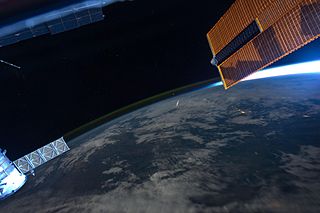
Comet Swift–Tuttle is a large periodic comet with a 1995 (osculating) orbital period of 133 years that is in a 1:11 orbital resonance with Jupiter. It fits the classical definition of a Halley-type comet, which has an orbital period between 20 and 200 years. The comet was independently discovered by Lewis Swift on July 16, 1862 and by Horace Parnell Tuttle on July 19, 1862.

Comet 252P/LINEAR is a periodic comet and near-Earth object discovered by the LINEAR survey on April 7, 2000. The comet is a Jupiter family comet, meaning that it passes quite close to the orbit of Jupiter.

460P/PanSTARRS (also known with the provisional designation P/2016 BA14) is a near-Earth object and periodic comet of the Jupiter family, with an orbital period of 5.25 years. In March 2016 it passed at distance of 2.2 million miles (3.5 million km, or 9 lunar distances) from Earth. It was the closest approach by a comet since 1770 and 3rd closest recorded comet to Earth. The close flyby enabled the size of the nucleus to be calculated at about 1 km (0.62 mi) in diameter, which was much bigger than expected. The comet is very dark, reflecting about 2-3 percent of the visible light, about the same as a charcoal briquette. It has a very similar orbit as numbered comet 252P/LINEAR, and may be related to it (e.g. split off of).
A hyperbolic asteroid is any sort of asteroid or non-cometary astronomical object observed to have an orbit not bound to the Sun and will have an orbital eccentricity greater than 1 when near perihelion. Unlike hyperbolic comets, they have not been seen out-gassing light elements, and therefore have no cometary coma. Most of these objects will only be weakly hyperbolic and will not be of interstellar origin.
2010 GZ60 was originally estimated by JPL to be a near-Earth asteroid approximately 2 kilometers (1.2 miles) in diameter. But is now known to be an asteroid from the inner region of the asteroid belt that does not get closer than 1.5 AU (220 million km) to Earth.
C/2021 O3 (PanSTARRS) is perhaps an Oort cloud comet, discovered on 26 July 2021 by the Pan-STARRS sky survey. It came to perihelion on 21 April 2022 at 0.287 AU (42.9 million km). from the Sun.
2022 AP7 is a kilometer-sized Apollo asteroid and potentially hazardous object orbiting between Venus and Jupiter. It was discovered on 13 January 2022 by Scott Sheppard at Cerro Tololo Observatory. Based on its absolute magnitude (H), 2022 AP7 is likely the largest potentially hazardous object identified in the eight years prior to its 2022 discovery.

















